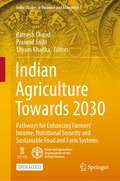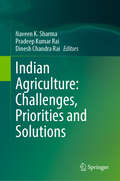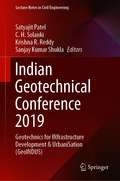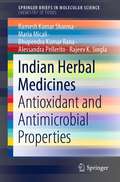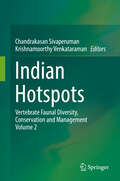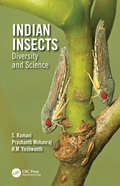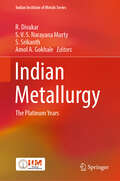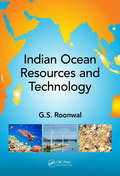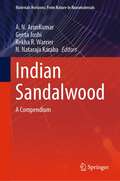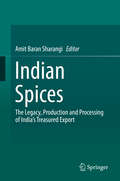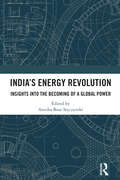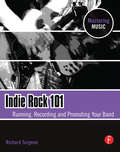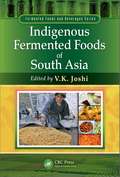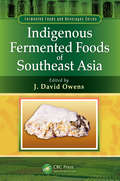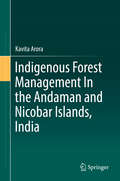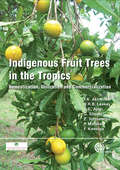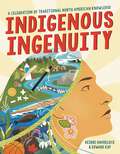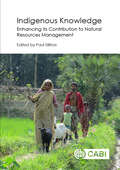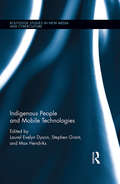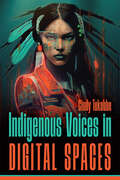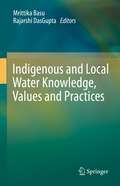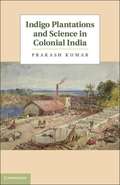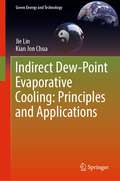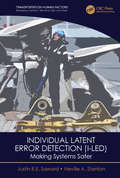- Table View
- List View
Indian Agriculture Towards 2030: Pathways for Enhancing Farmers’ Income, Nutritional Security and Sustainable Food and Farm Systems (India Studies in Business and Economics)
by Ramesh Chand Pramod Joshi Shyam KhadkaThis open access book brings together varying perspectives for transformational change needed in India’s agriculture and allied sectors. Stressing the need of thinking for a post-Green Revolution future, the book promotes approaching this change through eight broad areas, indicating the policy shifts needed to meet the challenges for the coming decade (2021-2030).The book comprises of ten contributions. Apart from the overview chapter on transformational change and the concluding chapter on pathways for 2030, there are eight thematic chapters on topics such as transforming Indian agriculture, dietary diversity for nutritive and safe food; climate crisis and risk management; water in agriculture; pests, pandemics, preparedness and biosecurity natural farming; agroecology and biodiverse futures; science, technology and innovation in agriculture; and structural reforms and governance. The writing style of these papers written by technical experts is forward-looking—not merely an analysis of what has been and why it was so, but what ought to be.This is an essential reading for those interested in agriculture, food and nutrition sectors of India, and more so their interconnectedness.
Indian Agriculture: Challenges, Priorities and Solutions
by Naveen K. Sharma Dinesh Chandra Rai Pradeep Kumar RaiThis edited volume examines the challenges and solutions in the intricate landscape of Indian agriculture and global trade. It explores the historical shifts from an industry-driven to agrarian economy, followed by rapid urbanization in the latter half of the 20th century. Modern agri-business is a global phenomenon not only affected by local and regional factors but also by global policies directed by global agencies. This book focuses on problems commonly associated with the advancement of agriculture in India, as well as issues arising out of global agricultural trade. The book contains chapters on associated problems, some priority issues, and approaches that could be used to overcome these limitations. Focused on rural India, the book underscores the critical role of agriculture, contributing a major part to the national income. The book highlights the economic opportunities arising from agriculture, emphasizing the need for sustainable practices given ecological, cultural, and socio-economic impacts. Addressing the complexities, the book advocates for diversification, adaptive varieties, and technological integration, including biotechnology and information technologies, to ensure the sustainability of agriculture. It also stresses the urgency of coherent national policies for soil and water resource use, marketing, business management, climate impacts, and more. It outlines key interventions and frameworks designed to guide actions on food security and nutrition, making a case for India's crucial role in global food production and supply chain systems. The book has been written and edited by leading researchers of the respective fields. It is a useful resource for students, researchers, academicians as well as farmers and policymakers.
Indian Geotechnical Conference 2019: Geotechnics for INfrastructure Development & UrbaniSation (GeoINDUS) (Lecture Notes in Civil Engineering #140)
by Sanjay Kumar Shukla Krishna R. Reddy C. H. Solanki Satyajit PatelThis book comprises select proceedings of the annual conference of the Indian Geotechnical Society. The conference brings together research and case histories on various aspects of geotechnical and geoenvironmental engineering. The book presents papers on geotechnical applications and case histories, covering topics such as (i) Characterization of Geomaterials and Physical Modelling; (ii) Foundations and Deep Excavations; (iii) Soil Stabilization and Ground Improvement; (iv) Geoenvironmental Engineering and Waste Material Utilization; (v) Soil Dynamics and Earthquake Geotechnical Engineering; (vi) Earth Retaining Structures, Dams and Embankments; (vii) Slope Stability and Landslides; (viii) Transportation Geotechnics; (ix) Geosynthetics Applications; (x) Computational, Analytical and Numerical Modelling; (xi) Rock Engineering, Tunnelling and Underground Constructions; (xii) Forensic Geotechnical Engineering and Case Studies; and (xiii) Others Topics: Behaviour of Unsaturated Soils, Offshore and Marine Geotechnics, Remote Sensing and GIS, Field Investigations, Instrumentation and Monitoring, Retrofitting of Geotechnical Structures, Reliability in Geotechnical Engineering, Geotechnical Education, Codes and Standards, and other relevant topics. The contents of this book are of interest to researchers and practicing engineers alike.
Indian Herbal Medicines: Antioxidant and Antimicrobial Properties (SpringerBriefs in Molecular Science)
by Maria Micali Ramesh Kumar Sharma Rajeev K. Singla Alessandra Pellerito Bhupendra Kumar RanaThis book discusses the scope and limitations of the antimicrobial and antioxidant properties of foods as medicines or medicinal coadjuvants in traditional Indian herbal therapies. The first chapter introduces readers to the relevance of the Ayurveda system, its holistic classification approach, applications of selected herbs and the demonstrable efficacy of herbal extracts in terms of antimicrobial susceptibility. In turn, the second chapter discusses the antimicrobial properties and kinetic mechanisms of inhibition ascribed to selected vegetable extracts. The third chapter addresses the antioxidant power of phenolic compounds from vegetable products and herbal extracts. The book closes with a review of natural antioxidant agents’ role in the treatment of metabolic disorders. Written from an Indian perspective, this book unravels the chemistry of the traditional Indian diet and its impact on health. Further, it can serve as a reference for other traditional products with similar health claims.
Indian Hotspots: Vertebrate Faunal Diversity, Conservation And Management Volume 2
by Chandrakasan Sivaperuman Krishnamoorthy VenkataramanThis book offers a comprehensive account of India’s four biodiversity hotspots: the Himalaya, Indo-Burma, Western Ghats and Sri Lanka and Andaman and Nicobar Islands. With a focus on tropical rainforests, it includes more than 30 chapters covering different vertebrate fauna e.g. fishes, amphibians, reptiles, birds, and mammals, as well as topics such as conservation and management aspects.Written by experts in the field of biodiversity conservation and management, it offers ample new insights into a number of subjects related to the faunal communities of tropical forest ecosystems, providing a valuable resource for conservationists and researchers in the field of flora and fauna diversity.
Indian Insects: Diversity and Science
by S. Ramani Prashanth Mohanraj Yeshwanth HmInsects are the most interesting and diverse group of organisms on earth, many of which are useful as pollinators of crops and wild plants while others are useful as natural enemies keeping pestiferous insects in check. It is important to conserve these insects for our survival and for this the diversity of insect species inhabiting the different ecosystems of our country must be known. The cornerstone to studies of any kind of organismal diversity is their taxonomic identity. Even after over two and half centuries of studies, so little is known of the insect wealth of our country. It has contributions from taxonomists who have been studying Indian insects for long, this book offers up to date information on many important groups of Indian insects seeking to fill the lacuna of a long felt need for a comprehensive work on the taxonomy of Indian insects. Salient features: Provides an up-to-date taxonomy of major insect groups of India Presents identification keys with illustrations of several important groups of Indian insects Gives a new insight into why insects are so abundant Addresses fundamental questions in mechanoreception and cross kingdom interactions using insects as model systems Indian Insects: Diversity and Science is a festschrift to Professor C. A. Viraktamath, an insect taxonomist par excellence. It has been designed to cater to the needs of academicians, researchers and students who wish to identify insects collected from local environments and will be an invaluable aid for those working in the areas of systematics, ecology, behaviour, diversity and the conservation of insects.
Indian Metallurgy: The Platinum Years (Indian Institute of Metals Series)
by Amol A. Gokhale R. Divakar S. V. S. Narayana Murty S. SrikanthThe book marks the Platinum Jubilee of the Indian Institute of Metals, closely matching independent India's age. It is envisaged as a compilation of technical articles tracing the birth and growth trajectory of metallurgical science, engineering and technology in the nation, attempting a degree of prognostication covering the next quarter of a century. It contains the essence of the metallurgical research and development and industrial progress India has witnessed in the last 75 years. This book comprises technical articles written by industry leaders and eminent technocrats. It includes overviews by distinguished researchers who have strived to build foundations of new metallurgical research and engineering fields. It includes learned writings of persons associated with premier institutions heavily dependent on metallurgy and materials. They have made seminal contributions by nurturing the growth of metallurgical research and industrial production or have made first-hand contributions to building the great organisations we have today. Coinciding with the Platinum Jubilee year of the Indian Institute of Metals, this book brings out the enormous efforts of these individuals representing their organisations to share insights that led to their success as an entity. Similarly, several professionals who significantly contributed to the understanding of metallurgical engineering, have held important positions and steered the national strategic programmes or academically nurtured students in their illustrious careers also share their journey in this book. This book chronicles the significant advances made in the field of metallurgical science, engineering and technology in India, presenting the historical perspective and prospects in the format of a technical volume.
Indian Ocean Resources and Technology
by Ganpat Singh RoonwalThe current scenario provides an ideal opportunity to confer higher priority to the marine resources of the Indian Ocean, particularly in terms of integrated management of the deep sea, shallow sea and coastal resources. This will maximize their potential in the sustainable development goal (SDG) pattern, leading to an appropriate environmental management. Therefore, this book aims to provide an overview of the area and to highlight the potential market opportunities represented by this vast and rapidly developing nation. In doing so the following aspects have been covered: Exclusive title focussing on mineral resources of Indian ocean. Discusses living, nonliving, ocean waves and tidal energy, ocean environment and protection aspects. Includes information on key themes, details of organizations associated with the Indian Ocean. Illustrates deep sea mining technology and environmental perspectives. Covers hydrocarbons-sub sea oil and gas, minerals from placer deposits to deep sea nodules, sea floor massive sulphides and cobalt rich encrustations.
Indian Sandalwood: A Compendium (Materials Horizons: From Nature to Nanomaterials)
by A. N. Arunkumar Geeta Joshi Rekha R. Warrier N. Nataraja KarabaThis book provides a global perspective of Indian Sandalwood categorized as ‘Vulnerable’ by the International Union for Conservation of Nature. It deals with history, distribution, propagation, chemistry, utilization, improvement, trade, and conservation in the present context. This book explores ways and means for restoring its past glory by creating awareness for its conservation and sustainable utilization. The content encompasses informative tables, appropriate graphs and figures, and illustrations with photographs and line drawings. This compendium would be useful for foresters, forestry professionals, botanists, policymakers, conservationists, NGOs, and researchers in the academia and the industry sectors.
Indian Spices: The Legacy, Production And Processing Of India's Treasured Export
by Amit Baran SharangiThis work comprehensively covers the production, processing and post harvest technology of Indian spices with an added focus on the history and uniqueness of this legendary regional product. Individual chapters describe the unique aspects of these spices and their production, post harvest technology and value addition, molecular breeding, organic farming aspects, climate change effects and bioactive compounds. Seasonal, preparatory, and storage conditions resulting in composition variations are explored. Indian Spices: The Legacy, Production and Processing of India’s Treasured Export begins by outlining the historical legacy of Indian spices and describing the many aspects that make this product so unique and highly valued. The abundance and variety of these spices are also delineated. Further chapters focus on current research involving the production technology involved in production, management, harvesting and processing of Indian spices along with post harvest processes, storage and transportation. Important and effective trends such as molecular breeding for spice crop improvement, tissue culture, climate change impacts, organic spices, extension strategies and secondary metabolites receive dedicated chapters. A valuable aspect of this work is the presentation of value chains for these spices, with extensive research presented on the marketing and export of the product. With the shift from localized distribution networks to a fully globalized industry, this book comes at an important time of growth for Indian spices and will be of major value to any researcher with interest in the past, present and future of this product.
India’s Energy Revolution: Insights into the Becoming of a Global Power
by Annika Bose StyczynskiIndia is the third-largest emitter of greenhouse gases, which makes it an important player whose climate mitigation actions and inactions are closely scrutinised. This book studies developments in India’s energy system from a governance perspective. It presents a unique compilation and synthesis of research findings that capture achievements, shortcomings, and persistent and transient challenges of India’s transition towards a net-zero economy by 2070.The book grounds its analysis in domestically formulated goals and reflects on dynamics at the structural level of India’s multi-scalar innovation system, by highlighting the influencing factors of energy system status and change. It presents the perspectives and positions of different actor groups, studies the market and business, and discusses cases influenced by existing or changing institutions across the whole spectrum of energy resources from fossil to non-fossil fuels and respective technologies.The volume will be useful for students and researchers in energy governance, energy policy and economics, socio-technical transition studies, energy systems engineering, sustainable development, and environmental studies. It will also be of interest to policymakers and investors.
Indie Rock 101: Running, Recording, Promoting your Band (Mastering Music Ser.)
by Richard TurgeonIndie Rock 101 is a clear, concise, all-in-one primer for beginning to mid-level musicians looking for the essential fundamentals behind running, recording and promoting their band. It's all the basics that can take years to collate from more specialized or technical books, magazines and websites-and it's written by a real independent musician.* Part I, Running Your Band covers the topics most relevant to forming and running the band: the people, practice and songwriting* Part II, Recording covers pre-production considerations, gear and how-to basics, and timeless fundamentals and techniques around recording, mixing and mastering* Part III, Promoting covers what you need to know to establish and grow your fan base, including graphic design, your press kit and website, sharing and selling your music, playing out and making a videoWhether you're just starting out or looking for a 360-degree primer to help take your music to the next level, Indie Rock 101 is the one book that covers it all.Featuring photos and Q&As from:Birdmonster * CDBaby founder Derek Sivers * Juliana Hatfield * John Vanderslice * Karate * Mark Kozelek of
Indigenous Fermented Foods of South Asia (Fermented Foods and Beverages Series)
by V. K. JoshiIndigenous Fermented Foods of South Asia covers the foods of India, Pakistan, Bangladesh, Sri Lanka, Nepal, Bhutan, Maldives, and Afghanistan. For each type of food, its microbiology, biochemistry, biotechnology, quality, and nutritional value is covered in depth.The book discusses numerous topics including various types of fermented foods, their o
Indigenous Fermented Foods of Southeast Asia (Fermented Foods and Beverages Series)
by J. David OwensBrings Together Current Knowledge and State-of-the-Art Information on Indigenous Fermented FoodsFermented foods and beverages span a range of root crops, cereals, pulses, vegetables, nuts, fruits, and animal products. Southeast Asia has a long history of utilizing fermentation in the production and preservation of foods, and is widely recognized fo
Indigenous Forest Management In the Andaman and Nicobar Islands, India
by Kavita AroraThis book offers an extensive study of indigenous communities in the Andaman and Nicobar Islands, India, and their methods of forest conservation, along with an exploration of the impact of forestry operations in the islands and the wide scale damage they have incurred on both the land and the people. Through an in-depth analysis of the contrasting indigenous practices and governmental forestry schemes, the author has compared the modern ‘Joint Forest Management’ resolution with the ethos and practices of the indigenous people of the Andaman and Nicobar Islands. Throughout the book, readers will learn about the different indigenous communities inhabiting these islands and the treasure of knowledge each of them provide on forest conservation. The book establishes that the notion of knowledge is politicized by the dominant culture in the context of Andaman’s forest tribes, and traces how this denial of the existence of indigenous knowledge by government officials has led to reduced forest area in the region. The book also explores and analyses strategies to utilize and conserve the tribes' profound knowledge of the biodiversity of the islands and study their efforts towards forest conservation, protection and rejuvenation.
Indigenous Fruit Trees in the Tropics: Domestication, Utilization and Commercialization
by Festus K. Akinnifesi Oluyede C. Ajayi Patrick Matakala Freddie R. Kwesiga Gudeta Sileshi Zac Tchoundjeu Roger R. B. LeakeyFocusing on livestock production systems, this comprehensive text addresses how the growing diversity of global food demands will be met in the future, providing insights into new and emerging scientific areas and the implications for addressing global drivers for change.
Indigenous Ingenuity: A Celebration of Traditional North American Knowledge
by Edward Kay Deidre HavrelockCelebrate Indigenous thinkers and inventions with this beautifully designed, award-winning interactive nonfiction book—perfect for fans of Braiding Sweetgrass. <P><P>Corn. Chocolate. Fishing hooks. Boats that float. Insulated double-walled construction. Recorded history and folklore. Life-saving disinfectant. Forest fire management. Our lives would be unrecognizable without these, and countless other, scientific discoveries and technological inventions from Indigenous North Americans. Spanning topics from transportation to civil engineering, hunting technologies, astronomy, brain surgery, architecture, and agriculture, Indigenous Ingenuity is a wide-ranging STEM offering that answers the call for Indigenous nonfiction by reappropriating hidden history. <P><P>The book includes fun, simple activities and experiments that kids can do to better understand and enjoy the principles used by Indigenous inventors. Readers of all ages are invited to celebrate traditional North American Indigenous innovation, and to embrace the mindset of reciprocity, environmental responsibility, and the interconnectedness of all life.
Indigenous Knowledge: Enhancing its Contribution to Natural Resources Management (Indigenous Knowledge And Development Ser. #Vol. 39)
by David A. Cleveland Roy Ellen James Fraser James Fairhead Samara Brock Melissa Leach Christopher Shepherd Patricia Howard Johannes Lehmann Delphine Renard Daniela Soleri Andrew Ainslie Kojo Amanor Jeff Bentley Stephen Brush Luisa Cortesi Michael R Dove Romain Duda Álvaro Fernández-Llamazares Sandrine Gallois Chris Hebdon Samuel Guindo Sascha Huditz Amy Leigh Johnson Alder Keleman J Stephen Lansing Rosalinda Hidalgo Ledesma Francis Michael Ludlow Doyle McKey Citlalli López Binnqüist Paul Van Mele Tom Van Mourik Lars Otto Naess Florencia Palis Fortunata Panzo Panzo Victoria Reyes García Gede Sedana Professor Paul Sillitoe Dawit Solomon Sidi Toure Thérèse De Vet Wayan Windia Gérard ZoundjiIndigenous Knowledge (IK) reviews cutting-edge research and links theory with practice to further our understanding of this important approach's contribution to natural resource management. It addresses IK's potential in solving issues such as coping with change, ensuring global food supply for a growing population, reversing environmental degradation and promoting sustainable practices. It is increasingly recognised that IK, which has featured centrally in resource management for millennia, should play a significant part in today's programmes that seek to increase land productivity and food security while ensuring environmental conservation. By drawing together strands of biocultural diversity research into natural resources management, this book: - Provides an overview of conceptual issues around IK and its contributions to sustainable agriculture and environmental conservation; - Addresses key themes via case studies from bioculturally diverse regions of the world; - Displays a wide range of methodologies and outlines a possible agenda to guide future work. An invaluable resource for researchers and postgraduate students in environmental science and natural resources management, this book is also an informative read for development practitioners and undergraduates in agriculture, forestry, geography, anthropology and environmental studies.
Indigenous People and Mobile Technologies (Routledge Studies in New Media and Cyberculture)
by Laurel Evelyn Dyson Stephen Grant Max HendriksIn the rich tradition of mobile communication studies and new media, this volume examines how mobile technologies are being embraced by Indigenous people all over the world. As mobile phones have revolutionised society both in developed and developing countries, so Indigenous people are using mobile devices to bring their communities into the twenty-first century. The explosion of mobile devices and applications in Indigenous communities addresses issues of isolation and building an environment for the learning and sharing of knowledge, providing support for cultural and language revitalisation, and offering the means for social and economic renewal. This book explores how mobile technologies are overcoming disadvantage and the tyrannies of distance, allowing benefits to flow directly to Indigenous people and bringing wide-ranging changes to their lives. It begins with general issues and theoretical perspectives followed by empirical case studies that include the establishment of Indigenous mobile networks and practices, mobile technologies for social change and, finally, the ways in which mobile technology is being used to sustain Indigenous culture and language.
Indigenous Voices in Digital Spaces
by Cindy TekobbeIndigenous Voices in Digital Spaces applies Indigenous frameworks and epistemologies to online cultural movements through four case studies, including hashtags, memes, cryptocurrency, and digital artistry, and develops decolonizing practices for digital rhetoric, online identity work, and digital literacy practices. Tekobbe’s methods for analyzing and understanding Indigenous knowledges online center Indigenous storytelling and “thick” (broad, deep, and complex) Indigenous meaning-making. Employing this thickness to interpret Indigenous knowledge ways resists the settler-colonial logics that tend to flatten complex Indigenous concepts into one-note representations of racial stereotypes. Native Americans’ use of social media and digital platforms to support social movements uniquely constructs Indigenous identities as living, producing, and culture-making people, which confronts the commonplace, one-dimensional narrative that Indigenous North Americans either live in isolation or are people of history resigned to the long-forgotten past. Tekobbe’s methods are applicable to additional online research to break through Western paradigms of oppositional critique, the colonial power matrix embedded in hierarchical and taxonomical classification systems, and participant objectification. Indigenous Voices in Digital Spaces offers new methodological and epistemological opportunities to explore digital communities and technologies, problematizing conventional Western critique. This book is useful to instructors in Indigenous studies, internet studies, digital literacies, cultural studies, and communications, as well as Indigenous and internet studies researchers.
Indigenous and Local Water Knowledge, Values and Practices
by Rajarshi DasGupta Mrittika BasuThis book provides a knowledge base of the existing indigenous and local water knowledge, values, and practices, and how this water knowledge can be mainstreamed into the decision-making process. The book not only demonstrates the perks of using indigenous knowledge but also illustrates the barriers and gaps that should be considered while planning for mainstreaming traditional knowledge and values at a local scale. The chapters incorporate case studies from various parts of the world demonstrating how indigenous, and religious and cultural values of water have translated into water use and conservation behavior among indigenous people ensuring resource sustainability over a long period of time. There has been global attention towards combining indigenous and local knowledge with new information and innovation to attain future water security. In this regard, this book is timely, relevant, and significant as it is the first attempt, as per the best of our knowledge, to publish a book that solely addresses indigenous and local knowledge, values, and practices regarding water management, quality monitoring, use, and conservation. With increasing emphasis on the inclusion of indigenous and local knowledge into natural resource governance and conservation by international agencies like the Intergovernmental Science-Policy Platform on Biodiversity and Ecosystem Services (IPBES), the proposed book will significantly contribute to the existing knowledge base and demonstrate the importance of mainstreaming indigenous water knowledge and practices into water governance and decision making. The UN SDGs, recognizing the significance of indigenous knowledge systems, emphasized its inclusion in most aspects and principles of SDGs. Apart from direct links with SDGs like zero hunger (SDG 2), no poverty (SDG 1), and climate action (SDG 13), indigenous and local knowledge system is considered to be directly connected to clean water and sanitation (SDG 6). The book will be useful to researchers and students in the field of indigenous knowledge and education, water governance, community-level planning, and water sustainability. The book can be referred to for postgraduate courses and beyond, as well as policymakers, conservationists, non-governmental organizations, development practitioners, and local government officials.
Indigo Plantations and Science in Colonial India
by Prakash KumarPrakash Kumar documents the history of agricultural indigo, exploring the effects of nineteenth-century globalisation on this colonial industry. Charting the indigo culture from the early modern period to the twentieth century, Kumar discusses how knowledge of indigo culture thrived among peasant traditions on the Indian subcontinent in the early modern period and was then developed by Caribbean planters and French naturalists who codified this knowledge into widely disseminated texts. European planters who settled in Bengal with the establishment of British rule in the late eighteenth century drew on this information. From the nineteenth century, indigo culture became more modern, science-based and expert driven, and with the advent of a cheaper, purer synthetic indigo in 1897, indigo science crossed paths with the colonial state's effort to develop a science for agricultural development. Only at the end of the First World War, when the industrial use of synthetic indigo for textile dyeing and printing became almost universal, did the indigo industry's optimism fade away.
Indirect Dew-Point Evaporative Cooling: Principles and Applications (Green Energy and Technology)
by Kian Jon Chua Jie LinThis book systematically discusses state-of-the-art dew-point evaporative cooling and provides key insights into current research efforts and future research interests. Novel energy-efficient and environment-friendly cooling technologies are essential to reduce the sharply rising energy consumption and greenhouse gas emissions and achieve carbon neutrality. Conventional air-conditioners which adopt a vapor compression cycle are neither energy-efficient nor sustainable due to the use of compressors and chemical refrigerants, as well as their intrinsic coupling of sensible and latent cooling loads. With the merits of high energy efficiency and the ability to decouple cooling loads without using chemical refrigerants, indirect dew-point evaporative cooling provides an ideal alternative solution to air conditioning in a variety of applications. A comprehensive review of evaporative cooling and their underlying engineering challenges is included. Advanced engineering and modeling experience critical to the development of dew-point evaporative coolers are highlighted. The effective analysis techniques for dew-point evaporative coolers are documented, and their intrinsic characteristics captured by these methods are reported. Lastly, advanced dew-point evaporative cooling systems in various energy-connected applications are discussed by providing multiple case studies. Specifically targeted at HVAC engineers, thermal scientists, and energy-engineering researchers, this book will balance fundamental concepts, industrial applications, and leading-edge research. As this book provides readers with depth and breadth of coverage, it can also be used by graduate-level students in relevant fields.
Indirect Food Additives and Polymers: Migration and Toxicology
by Victor O. SheftelMore foods are now packaged in containers designed for direct cooking or heating, which encourages movement of substances into the foods. Indirect Food Additives and Polymers: Migration and Toxicology is an impressive review of basic regulatory, toxicological, and other scientific information necessary to identify, characterize, measure, and predict the hazards of nearly 2,000 of the plastic-like materials employed in packaging and identified by the FDA as indirect food additives. It presents the data underlying federal regulations, previously unavailable in one volume, and is a convenient resource for anyone working in the large number of related disciplines.
Individual Latent Error Detection: Making Systems Safer (Transportation Human Factors)
by Neville A. Stanton Justin R.E. SawardUndetected human error in aircraft maintenance creates a latent error condition that can contribute to undesirable outcomes. Individual Latent Error Detection (I-LED) acts as an additional system safety control that helps an engineer recall past errors through environmental cues. This book addresses a gap in the human factors research and current safety strategies by exploring the nature and extent of I-LED and its benefit to safety resilience. The book will describe the I-LED concept using a systems perspective and propose practical interventions to be integrated within existing safety systems as an additional control to enhance resilience against human performance variability. Provides a new view of total safety based on enhanced resilience provided through the integration of I-LED interventions within existing safety systems Offers an in-depth exploration of the phenomenon of spontaneous recall of past event, leading to error detection and recovery of latent error conditions Discusses the application of Human Factors methods to conduct real-world observations in maintenance environments Describes the application of the systems view of human error to applied research Presents cost versus benefit analysis of safety interventions targeting latent error conditions
